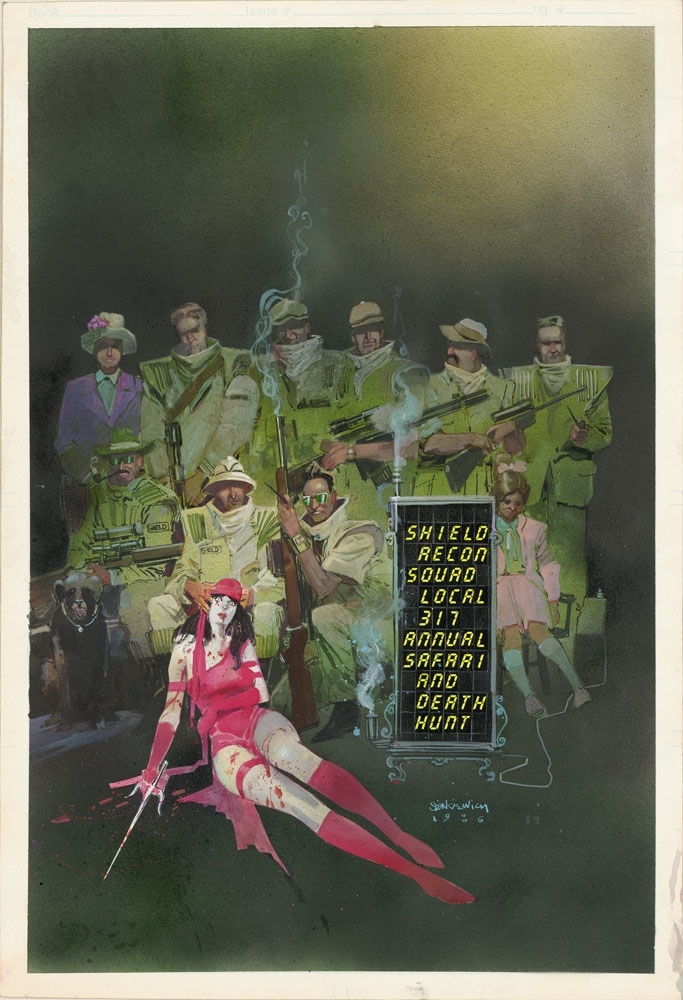Most of the artists I post about in here—maybe all of them—are what I would call stylists. By which I mean they rock the boat. They don't try to draw like anyone else, or in a house style, they all developed their own very unique styles and it really stands out from the crowd. And when it comes to the comic book artists, I believe all of them ink their own work. Not always, but you can really tell when somebody else inks it, and it's a loss in quality usually. I take that back—when it comes to Marc Silverstri, his best inker is Dan Green. They developed a synergy together that few teams have had.
Today my Punisher trade paperback came in. If possible, when it comes to artists I really like such as Tex, I try to get their work in reprint form in something like a trade or a collection or an omnibus. The problem with the omnibuses is the paper is super-thin, seems like it would tear or crease really easily, and the books are unbelievably massive. I like to hold a book in one hand in my lap and page through it with the other, and after a while if it's an omnibus, my wrist gets worn out. I mean these books weigh like ten pounds!! But it's an excellent way to collect an entire run by an artist or a writer, printed on nice slick paper with bright colors (sometimes inappropriately bright for the subject matter). But I didn't have to get an omnibus to cover Tex's entire run on The Punisher. He only drew a few stories in that title, so just a trade paperback covers it easily.
I plan to shoot pictures from the book and show the work of a variety of Punisher artists who work at different points along the spectrum from pure house style to one-of-a-kind stylist like Texeira at his peak. That'll probably be my next post, in this one I want to cover some different territory.
All my favorite artists have developed a very individual look and visual language and an unmistakable style of their own. I want to talk a bit about how they've done that while working in an industry like comic book publishing, which for a long time didn't allow much individualism. Or I should say it didn't allow a more modern artistic approach. Individual style was fine as long as it was close to the classic Marvel house style, which in the early days (up until somewhere in the 70's) was the Jack Kirby style.
There were several artists working in the bullpen who wanted to break loose and do something very different—Frank Miller, Bill Sienkiewicz, and Walter Simonson that I can think of offhand. I know Miller, and I think Sienkiewicz, would continually ask to be allowed to cut loose and try something more experimental, but they weren't allowed to until they had spent a good ten years proving themselves worthy and loyal to the brand by doing good workmanlike work. Often in their early stuff you can see hints and allegations of what was to come here and there—a few more loosely-rendered figures, an interesting compositional choice, etc. But their editors would reign them in and not let much of that slip through.
I'm not sure when it was exactly, but I think some time in the 70's they did start allowing it. The first stories I remember seeing in an innovative modernist style were Simonson's Metal Men comics. It was not a highly popular series at the time, probably failing, and I think he was put on it and allowed to do his thing—that modern comic thing he had been wanting to do for a decade or more—in order to field test it and see if it would be accepted by readers. Personally I loved it, and a lot of other people did as well. It really stood out from all the other titles on the spinner racks in the grocery stores in those days (which is where you would buy them. Comic book shops didn't exist until the 80's). I believe his work propelled Metal Men to a new level of popularity and generated loads of letters from readers asking about him and this exciting drawing style.





No comments:
Post a Comment